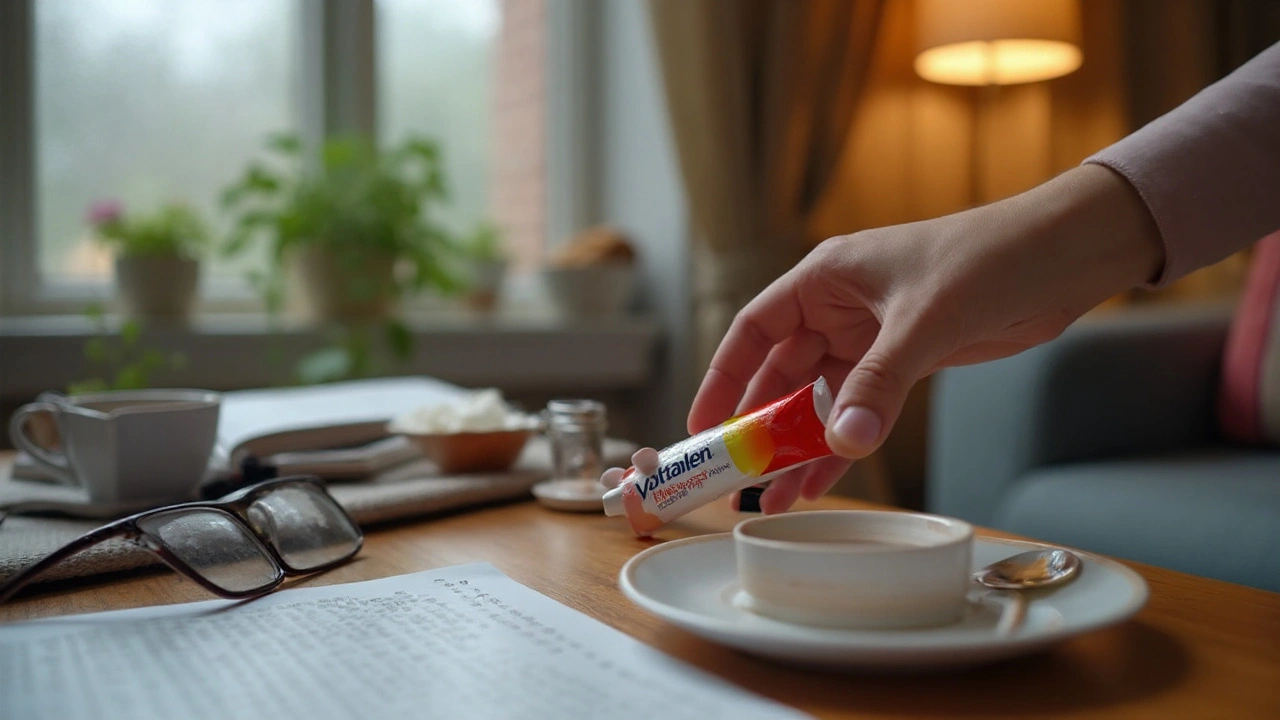Picture this: you’re out on a morning walk along the Bondi coastline, and you feel that old ache in your knee again. No surprise—it's a complaint I hear almost daily, especially as we try to keep active through our unpredictable Sydney winters and sticky summers. When pain strikes (whether from muscle strains, a sprained ankle, or that stubborn tennis elbow), most Aussies don’t sit around hoping the discomfort will just fade away. Instead, we go looking for something to ease the pain and get us moving again. That's where Voltaren comes into play. It's a name you see almost everywhere—on shelves at your local chemist, in TV ads promising quick relief, and in first-aid kits around town. But what’s really going on when you rub in that cooling gel or pop a pill? Does Voltaren actually work, or is it just clever marketing? Turns out, there’s a lot more to this humble tube than meets the eye.
What Exactly Is Voltaren and How Does It Work?
Voltaren is the go-to solution for many when joint or muscle pain threatens to ruin the day. But before reaching for it, you’d want to know what you’re actually using on (or inside) your body. Voltaren’s active ingredient is diclofenac, a type of nonsteroidal anti-inflammatory drug (NSAID). Don’t let that mouthful scare you—it just means that Voltaren is designed to cut down pain and swelling by blocking substances called prostaglandins. These are the chemicals your body releases in response to injury or irritation, causing inflammation and making you hurt more than you need to.
Voltaren comes in different forms: gel, cream, tablets, and even patches in some countries. The Voltaren gel is probably the most recognized here in Australia. Slide into any pharmacy and you’ll see it against the glass shelf, standing out in a blue and orange tube. The gel is special because you apply it directly on the sore spot: your knee after a dodgy step on the stairs, your back after hauling groceries, or your wrist after a few too many hours on the laptop. By rubbing it in, you’re basically delivering medication where it’s needed, bypassing your gut. That means less risk of stomach irritation, something oral NSAIDs are famously known for.
For those who really need it, oral Voltaren (tablets and capsules) exists as well. Here, the diclofenac works systemically. That means it moves through your bloodstream, attacking inflammation all over your body. It’s handy for more widespread pain, like arthritis, or when topical stuff just won’t cut it.
Ever wondered just how many people are using this stuff? Here’s a quick stat: In Australia, over three million scripts for diclofenac are filled each year, according to the Therapeutic Goods Administration. And that doesn’t even count over-the-counter sales! The numbers are staggering, showing just how common aches and pains are—and how much faith we put in products like Voltaren to keep us active.
People have trusted Voltaren for decades (it first hit the market in the late 1970s). Its reputation comes from serious clinical testing. In dozens of studies, Voltaren outperformed placebos at reducing swelling and pain intensity in patients with osteoarthritis and soft tissue injuries. Australian guidelines even recommend topical NSAIDs like Voltaren gel as a first-line treatment for mild to moderate joint pain, especially when you want to avoid the tummy troubles that oral NSAIDs cause.
What makes Voltaren different from simply popping a Panadol or Nurofen? It’s all about that anti-inflammatory action. Simple painkillers just block pain messages in the brain; anti-inflammatories actually deal with the root cause—the inflammation around your joint or muscle.
If you’re weighing up which Voltaren to use, here’s a quick rundown:
- Voltaren Gel: Best for local aches, like a sore knee, tennis elbow, or sprained ankle. Rubbed onto unbroken skin 2-4 times daily. Great for people who can’t take oral NSAIDs.
- Voltaren Tablets: Good for more extensive pain, such as arthritis, or times when gels aren’t convenient. Swallowed with food to help prevent stomach issues.
- Voltaren Emulgel Extra Strength: Contains a higher dose for stubborn pains, but be careful: don’t apply more than the packaging suggests. More isn’t always better.
Whatever you choose, always check the packaging for dosing info or chat with your pharmacist if you’re not sure. Using more doesn’t mean faster relief—it can actually up your risk of side effects.
To make it easy to compare the different Voltaren types, here’s a handy table:
| Product Form | How Used | Best For | Onset of Relief | Common Side Effects |
|---|---|---|---|---|
| Gel/Cream | Applied to skin locally | Sprains, strains, osteoarthritis | Within 1 hour | Skin irritation, rash |
| Tablets/Capsules | Swallowed with water/food | Systemic arthritis, back pain | 30-60 minutes | Stomach upset, heartburn |
| Patches* | Stuck on skin | Chronic pain (rare in Australia) | 1-2 hours | Skin rash |
*Patches are approved in some countries but less common in Australia.

Who Should Use Voltaren—and Who Shouldn’t?
So, you’ve got a bottle of Voltaren gel in your hand, or maybe a pack of tablets. Is it for everyone? Not quite. Like anything in medicine, there’s a right time and a right person for Voltaren. The stuff is a lifesaver for weekend warriors, those with age-related joint pain, and even folks who get hurt in freak accidents (like my mate Greg, who rolled his ankle hopping off a bus—a classic Sydney move). It’s especially useful if you need fast relief that doesn’t knock you out or upset your gut—think about trying it after gardening, long runs, or even just wrangling the grandkids for an afternoon.
People with osteoarthritis in their knees or hands usually find topical Voltaren a solid relief. The Arthritis Australia website and Aussie GPs stand by it as a first port of call before launching into heavier painkillers. Young and old alike can use Voltaren, but always double-check the age restrictions on the pack, especially for kids and teens.
But there are a handful of people who should steer clear or use it only with their doctor’s tick of approval. If you’ve ever had an allergic reaction to NSAIDs—think hives, trouble breathing, or sudden swelling—you absolutely should not use Voltaren. The same goes if you have active stomach ulcers, heart failure, kidney problems, or bleeding disorders. And for pregnant women? Doctors say avoid it in your third trimester; there’s solid evidence it can affect your baby’s heart and kidney function. If you’re trying to get pregnant, be careful—NSAIDs in general might make it harder, so best to ask your doc.
Common sense goes a long way. Never apply Voltaren to broken skin, open wounds, or areas with eczema. Rinse your hands after applying (unless your hands are the part that’s sore), and avoid getting it near your eyes or mouth. Noticed redness, itching, or burning? Wash it off right away and talk to your GP or pharmacist. It can bring a mild cooling sensation, but anything stronger or painful isn’t normal.
It’s easy to think of Voltaren gel as “just a cream,” but you can run into problems if you’re already using other NSAIDs like aspirin, ibuprofen, or naproxen. Doubling up can boost your risk of stomach ulcers or kidney issues. Always check what meds you’re already taking and, if in doubt, show your list to a pharmacist—most are more than happy to help double-check the combos.
How long should you keep using Voltaren? As a rule of thumb, if you aren’t seeing a difference in your pain after a week with the gel (or a few days with the tablets), it’s time to stop and get checked out. Prolonged use, especially with the oral form, ups your risk for side effects and isn’t going to magically fix the root issue. The goal is to take the lowest dose, for the shortest time. Your body will thank you, trust me.
Here's a quick list for when not to use Voltaren without getting advice first:
- History of allergic reactions to other painkillers (especially NSAIDs).
- Stomach, liver, kidney, or heart problems.
- Pregnancy—especially late pregnancy.
- Using other anti-inflammatories or blood thinners.
- Children under 12 (with the topical gel) or under 18 (with oral forms), unless your doctor says it’s okay.
If you’ve got any doubts about whether you’re in the clear, a quick chat with your GP or pharmacist goes a long way. Better to be safe, right?
For those who tolerate it well, Voltaren is a real workhorse. My mate Sally, a marathon runner, swears by the stuff after every race. So does my elderly neighbor, who has arthritis in both knees. Just remember, not every pain needs medication—think of Voltaren as an assistant, not a long-term solution if pain doesn’t budge this time around.

Tips, Side Effects, and Interesting Things Nobody Tells You About Voltaren
Voltaren might feel like an old friend at this point, but there’s a bit you should know to squeeze out the benefits—and dodge the downsides. One thing many people miss? Timing. Applying Voltaren gel after a warm shower (when your blood flow is up) helps it soak in. You only need a small amount; if you’re slathering it on so thick it’s white, you’re probably wasting product. For joints like knees and elbows, move the joint gently as you rub in the gel. It’s safe to use with gentle stretching exercises, which can actually make the aches go away faster.
Sun worshippers, pay attention: Voltaren gel can make your skin a tiny bit more sun-sensitive, so don’t rub it on and then hit the beach. Cover up the area with clothing or slap on some sunscreen. That goes double for folks using it before sporting sessions—no one needs patchy sunburn marks just because of a bit of knee pain.
Most folks breeze through using topical Voltaren without major drama. But some aren’t so lucky. Side effects aren’t common, especially with the gel, but they’re worth knowing about. Watch for local reactions like redness, peeling, or itchiness. If your mouth or eyes are burning—wash up now and see a doctor if it stays bad.
The pills and capsules are a different story. Taking those for more than a few days is where trouble can brew: tummy pain, ulcers, bleeding, nausea, diarrhoea, and heartburn make the list. Rarely, Voltaren can increase blood pressure or make heart and kidney troubles worse. That’s why it’s only for short bursts unless the doc has you on a set plan. Want proof? A well-known UK study published in “The Lancet” found a small increased risk of heart issues with long-term NSAID use—nothing to panic about if you’re using it right, but a reminder to not get complacent.
Mixing Voltaren with alcohol isn’t strictly off limits, but if you’re taking oral Voltaren, think twice before downing a few pints at the pub. Both can irritate your tummy, and together, they up your risk of a stomach bleed. If you’re just using the gel and keep it local, you’re generally fine. Of course, moderation in all things makes life easier.
Here’s something even regular users miss: Voltaren gel can interact with other products. Certain moisturisers, sunscreens, or even medicated creams might make your skin react or lower how well the Voltaren gels sinks in. Give each product at least 30 minutes to dry before layering. Don’t mix and match unless you really know what you’re doing.
People sometimes ask if Voltaren can fix everything—like chronic back pain that’s been sticking around for years. The honest answer? It’s great for short-term injuries and mild arthritis flares, but if you’re needing it every day for months, your body might be screaming for a new approach. Multiple studies, including recent Aussie reviews, point out that pain that lingers more than a week deserves a proper diagnosis—not just a tube of gel.
If you’re looking to get off Voltaren but still want relief, don’t rush to swap for something else. A mix of gentle exercise, warm bid baths, and even mindfulness plays a role in modern pain management. It’s not just about medication—it’s about the big picture.
One last tip: always check the expiry date. Voltaren doesn’t work as well past its prime. Store it below 30°C and don’t leave it in the car at the beach—Sydney heatwaves can turn that miracle gel into a runny mess or reduce its punch. If it starts to smell weird or the colour changes, bin it.
So, next time you catch yourself wincing after a hard day or feel that familiar sting in your knee, you’ll know what to reach for, how it works, and how to keep things safe. And maybe, just maybe, you’ll impress your mates at the next BBQ with some proper Voltaren know-how.






Reviews
As someone from India, I've come across Voltaren in many local pharmacies and clinics. It's quite reassuring to know how effective it is for joint and muscle pain because so many people here suffer from arthritis and muscle strain due to our physically demanding lifestyles. I've personally found it useful when I had a sprained ankle after playing cricket, and the relief was noticeable within hours.
However, it’s important to be cautious about usage. People often underestimate the side effects of topical pain relievers, thinking they're completely harmless because they’re applied on the skin. But as the article points out, reading the label and following instructions strictly makes a big difference.
I also appreciate that the article touches upon safe use—it is necessary to avoid overusing these kinds of meds, especially when you might have underlying health conditions. It’s always best to consult a doctor if the pain persists.
Does anyone know about Voltaren being used for chronic conditions or is it purely for short-term relief? I’d love to hear other experiences.
Whoa, so Voltaren is like my go-to for my back pain when I forget to stretch at work 😅 But honestly, I've always been kind of lazy about reading the side effect info or usage tips, so this is a solid reminder to be more careful.
Does anyone else get weird rashes from it? I used it twice and felt a little burning on my skin, but shrugged it off thinking I was just sensitive.
One thing I find kinda annoying is how they don’t clarify the max safe daily amount on the tube — that’s just bad design in my opinion. Needs to be clearer, especially for folks who might misuse it.
Anyway, emoji aside, pretty solid product for fast relief, but please be smart about it! 👍
It’s interesting to consider the careful balance between pain alleviation and the potential for side effects with products like Voltaren. In our daily experience, pain can often be more than a physical sensation; it also affects how we feel emotionally and spiritually.
This article reminds me to approach medication with mindfulness, looking beyond immediate relief and contemplating how our bodies respond not just superficially but holistically.
The tips about safe usage are practical, yet they also encourage us to be present and intentional with how we treat our pain. Sometimes we seek quick fixes, but this reinforces that understanding your treatment fully is a kind act to oneself.
I wonder how cultural differences influence people’s acceptance and trust in such products. In India, for example, there’s often a blend of allopathic and traditional approaches, which can be complementary if well-informed.
Thanks for this clear explanation! The segment about the common side effects was especially well-written, with no grammatical ambiguities. I appreciate how the post avoids unnecessary jargon, making it accessible for a broad audience without sacrificing accuracy.
However, I noticed that 'uses' should always be consistently capitalized in the heading or kept lowercase for stylistic consistency. Small details like that are important in conveying professionalism in educational materials.
Content-wise, the facts presented align well with clinical data about NSAIDs like diclofenac, the active ingredient in Voltaren. Readers looking for evidence-based insights will find this reassuring.
It might also help to link to peer-reviewed studies or official guidelines for interested users who want to delve deeper into pharmacodynamics.
Hey everyone! Just wanted to jump in and say I love seeing posts like this that break down common meds we use daily. Voltaren's relief for joint and muscle pain has helped so many of my clients recover faster after injury.
One quick tip: when using topical gels like Voltaren, make sure to wash your hands thoroughly after application. I’ve seen cases where touching the eyes accidentally causes irritation.
Also, layering creams or lotions on top after Voltaren can dilute its effect, so it’s better to wait a bit or speak to your healthcare provider about the best routine.
Let’s keep sharing such useful health info for anyone dealing with pain—it’s empowering to be equipped with the right knowledge! 😊
This Voltaren overview seems decent, but honestly, I’ve seen way too many ads disguised as info posts about pain relief meds. People get sold the idea that these creams are miracle cures when they’re just band-aids.
Sure, it helps reduce inflammation and pain temporarily, but nothing replaces proper rest, exercise, and lifestyle changes. And side effects? Let's just say I wouldn’t blindly trust anything that requires such disclaimers.
Also, you better check where these ingredients come from. Some companies cut corners or push harmful chemicals under the radar.
I’m skeptical of quick fixes and always encourage people to dig deeper instead of settling for superficial solutions. Pain isn't just a symptom; it’s a sign that your body needs attention on multiple levels.
Alright, lemme just say this bluntly—Voltaren is overrated. Maybe it works for some but I had a downright awful experience. The side effects hit me like a freight train: skin irritation, weird headaches, and no, it didn’t relieve the damn pain effectively.
People often overlook how these NSAID gels can sometimes open the door to much worse problems, especially if you got a sensitive system or other meds running through your veins. It’s not a magic potion, and no, FDA approval doesn’t guarantee jack shit about how YOU will respond to it.
If you’re thinking this stuff will give you a miracle fix, think again. Just another symptom-suppressor that big pharma loves to shove down our throats. Instead, build a pain management plan that includes physio, diet changes, and mindfulness.
Seriously, be smart, folks.
Allow me to provide a more formal perspective on Voltaren as a topical nonsteroidal anti-inflammatory drug (NSAID). The active component, diclofenac, has been clinically validated to reduce inflammation and alleviate musculoskeletal pain efficiently when used as directed.
It is imperative, however, for patients to adhere strictly to dosing parameters laid out by healthcare professionals to prevent systemic exposure that can lead to adverse effects such as gastrointestinal disturbances or cardiovascular risks.
Patients with pre-existing conditions must consult physicians prior to use. The content clearly states the necessity for vigilance concerning common side effects, which is commendable.
Overall, this educational text serves as an effective primer for laypersons seeking introductory knowledge about Voltaren.
Wow, pain relief is such a huge topic, and it’s crazy how many options there are out there. Voltaren definitely pops up often as a quick fix, but I really appreciate when articles like this one make us think twice about what exactly we’re putting on our skin. 🌿
It makes me wonder about how pain itself is a messenger from our body—sometimes just silencing it isn’t enough, you gotta listen deeper. That said, it’s great to have trusted tools like Voltaren when you’re in a pinch and need genuine relief for everyday muscle or joint aches.
It’s also really empowering to learn about side effects and safe use because that way we make choices that respect our body’s intelligence and boundaries.
Anyone else find the balance between relief and acceptance kind of a personal journey? 💭
This was a helpful overview, honestly! I’ve used Voltaren before and knowing more about the safe use and side effects makes me feel more confident about using it again if needed.
Also, hats off to whoever wrote this — the way it breaks down the info is clear and digestible. No confusing medical jargon, just straight facts.
Remembering to consult a doctor if the pain lingers is key though. Sometimes we try to tough it out, but it’s always good to check in and make sure there isn’t something bigger going on.
If anyone’s got any personal tips on managing muscle or joint pain, I’m all ears!
Following up on my earlier comment, I wanted to address the question about chronic use. From what I understand and from my own experience, Voltaren is designed mainly for short-term relief. Chronic joint conditions usually require a different approach, involving a doctor’s supervision to avoid complications.
It’s good for flare-ups but not a long-term solution on its own. Combining it with physical therapy or lifestyle changes tends to offer better outcomes for those with ongoing joint issues.
If anyone with chronic pain is reading, definitely try to see a specialist before regular Voltaren use.
Appreciate that follow-up! That’s exactly what I tell my clients too. Voltaren is great for temporary relief but shouldn’t be the only strategy for managing chronic pain.
Also, layering on physiotherapy exercises after the inflammation subsides helps regain strength and flexibility, reducing future flare-ups. Don’t just rely on creams!
And yes, the hand washing tip is so underrated. In busy households, a quick rinse keeps others from picking up irritants inadvertently.
Good chat here, folks! Keep the questions coming.
Totally agree, the thing is the info is out there but it’s scattered. Posts like these make it way easier to know what’s up with meds like Voltaren.
About my rash thing? Probably just my skin being dumb lol. I double-checked and yep — some people do get mild irritation. So if you do too, maybe stop using it and ask a doc.
Thanks for clearing the chronic use doubts, btw! That’s good to know.
Such a warm and respectful exchange here. It’s lovely to see how much consideration people show toward both the physical and experiential aspects of pain.
When I reflect on the use of something like Voltaren, I’m reminded that our self-care is multilayered: physical healing, emotional well-being, and informed choices all knit together.
Many thanks for the perspectives shared; it enriches the understanding far beyond just using the product.
Yes! An informed community talking openly about these topics makes a huge difference. The journey with pain and relief is rarely straightforward, but knowledge like this lights the way.
Glad to be part of this discussion. 🌟